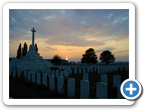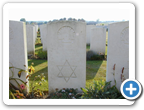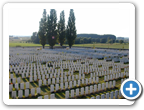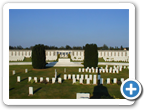The Western Front Today - Tyne Cot Cemetery
The largest British war cemetery in the world, Tyne Cot CWGC Cemetery was designed by Sir Herbert Baker. 11,908 graves are registered within Tyne Cot, making it a somewhat impersonal war cemetery: the sheer number of graves make it perhaps difficult to take in.
Of this total 70% are unknown. On the wall at the back of the cemetery are the names of 34,927 soldiers who have no known grave and died from August 1917 to the end of the war - a continuation of the names inscribed on the Menin Gate.
Inside the cemetery two mourning angels kneel on top of dome-covered pavilions at either end of the memorial wall, highlighting the harrowing nature of the conflict in this area, Passchendaele.
The two pavilions were built over German blockhouses.
Two remaining German blockhouses can be seen, one to the right of the entrance gate (through which the Cross of Sacrifice can be framed and is much photographed; this was, incidentally, built over the remains of a German pillbox at the suggestion of King George V), and the other to the left. Each are surrounded by poplars.
Pill boxes were extensively used in the Passchendaele area because the water table was so near to the surface.
In these circumstances it was better to build above rather than below ground.
The British however seldom constructed concrete pill boxes, on the basis that the war must be an offensive one, with pill boxes signifying a war of attrition.
When the cemetery was completed it received a constant stream of pilgrims from Ypres seeking out evidence of their loved ones. The name 'Tyne Cot' is said to originate (there is some dispute over this) from a reference by Northumberland Fusiliers during the war to the likeness of the German pillboxes to Tyneside cottages.
Film Footage of Tyne Cot (1)
Film Footage of Tyne Cot (2)
Film Footage of Tyne Cot (3)
References:
Before Endeavours Fade, Rose E.B. Coombs, After the Battle 1994
Major & Mrs Holt's Battlefield Guide - Somme, Leo Cooper 2000
A Kite Balloon was an observation balloon controlled by a cable from the ground.
- Did you know?















